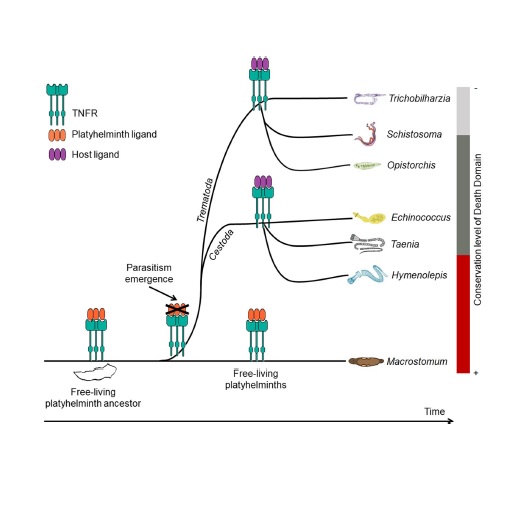The evolution of TNF signaling in platyhelminths suggests the cooptation of TNF receptor in the host-parasite interplay.
BERTEVELLO, Claudio R.; RUSSO, Bruno R. A.; TAHIRA, Ana Carolina; LOPES-JUNIOR, Ednilson Hilário; DE MARCO, Ricardo; OLIVEIRA, Katia C.
BERTEVELLO, Claudio R.; RUSSO, Bruno R. A.; TAHIRA, Ana Carolina; LOPES-JUNIOR, Ednilson Hilário; DE MARCO, Ricardo; OLIVEIRA, Katia C.




 Abstract: Background The TNF signaling pathway is involved in the regulation of many cellular processes (such as apoptosis and cell proliferation). Previous reports indicated the effect of human TNF-a on metabolism, physiology, gene expression and protein phosphorylation of the human parasite Schistosoma mansoni and suggested that its TNF receptor was responsible for this response. The lack of an endogenous TNF ligand reinforced the idea of the use of an exogenous ligand, but also opens the possibility that the receptor actually binds a non-canonical ligand, as observed for NGFRs. Methods To obtain a more comprehensive view, we analyzed platyhelminth genomes deposited in the Wormbase ParaSite database to investigate the presence of TNF receptors and their respective ligands. Using different bioinformatics approaches, such as HMMer and BLAST search tools we identified and characterized the sequence of TNF receptors and ligand homologs. We also used bioinformatics resources for the identification of conserved protein domains and Bayesian inference for phylogenetic analysis. Results Our analyses indicate the presence of 31 TNF receptors in 30 platyhelminth species. All platyhelminths display a single TNF receptor, and all are structurally remarkably similar to NGFR. It suggests no events of duplication and diversification occurred in this phylum, with the exception of a single species-specific duplication. Interestingly, we also identified TNF ligand homologs in five species of free-living platyhelminths. Conclusions These results suggest that the TNF receptor from platyhelminths may be able to bind canonical TNF ligands, thus strengthening the idea that these receptors are able to bind human TNF-a. This also raises the hypothesis that an endogenous ligand was substituted by the host ligand in parasitic platyhelminths. Moreover, our analysis indicates that death domains (DD) may be present in the intracellular region of most platyhelminth TNF receptors, thus pointing to a previously unreported apoptotic action of such receptors in platyhelminths. Our data highlight the idea that host-parasite crosstalk using the TNF pathway may be widespread in parasitic platyhelminths to mediate apoptotic responses. This opens up a new hypothesis to uncover what might be an important component to understand platyhelminth infections.
Abstract: Background The TNF signaling pathway is involved in the regulation of many cellular processes (such as apoptosis and cell proliferation). Previous reports indicated the effect of human TNF-a on metabolism, physiology, gene expression and protein phosphorylation of the human parasite Schistosoma mansoni and suggested that its TNF receptor was responsible for this response. The lack of an endogenous TNF ligand reinforced the idea of the use of an exogenous ligand, but also opens the possibility that the receptor actually binds a non-canonical ligand, as observed for NGFRs. Methods To obtain a more comprehensive view, we analyzed platyhelminth genomes deposited in the Wormbase ParaSite database to investigate the presence of TNF receptors and their respective ligands. Using different bioinformatics approaches, such as HMMer and BLAST search tools we identified and characterized the sequence of TNF receptors and ligand homologs. We also used bioinformatics resources for the identification of conserved protein domains and Bayesian inference for phylogenetic analysis. Results Our analyses indicate the presence of 31 TNF receptors in 30 platyhelminth species. All platyhelminths display a single TNF receptor, and all are structurally remarkably similar to NGFR. It suggests no events of duplication and diversification occurred in this phylum, with the exception of a single species-specific duplication. Interestingly, we also identified TNF ligand homologs in five species of free-living platyhelminths. Conclusions These results suggest that the TNF receptor from platyhelminths may be able to bind canonical TNF ligands, thus strengthening the idea that these receptors are able to bind human TNF-a. This also raises the hypothesis that an endogenous ligand was substituted by the host ligand in parasitic platyhelminths. Moreover, our analysis indicates that death domains (DD) may be present in the intracellular region of most platyhelminth TNF receptors, thus pointing to a previously unreported apoptotic action of such receptors in platyhelminths. Our data highlight the idea that host-parasite crosstalk using the TNF pathway may be widespread in parasitic platyhelminths to mediate apoptotic responses. This opens up a new hypothesis to uncover what might be an important component to understand platyhelminth infections. @article={003006851,author = {BERTEVELLO, Claudio R.; RUSSO, Bruno R. A.; TAHIRA, Ana Carolina; LOPES-JUNIOR, Ednilson Hilário; DE MARCO, Ricardo; OLIVEIRA, Katia C.},title={The evolution of TNF signaling in platyhelminths suggests the cooptation of TNF receptor in the host-parasite interplay},journal={Parasites and Vectors},note={v. 13, p. 491-1-491-12},year={2020}}
@article={003006851,author = {BERTEVELLO, Claudio R.; RUSSO, Bruno R. A.; TAHIRA, Ana Carolina; LOPES-JUNIOR, Ednilson Hilário; DE MARCO, Ricardo; OLIVEIRA, Katia C.},title={The evolution of TNF signaling in platyhelminths suggests the cooptation of TNF receptor in the host-parasite interplay},journal={Parasites and Vectors},note={v. 13, p. 491-1-491-12},year={2020}}